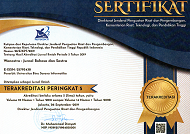ESP STUDENTS’ NEEDS ANALYSIS BASED ON THE LEARNING-CENTRED APPROACHED
Abstract
Abstract
English for Specific Purposes, known as ESP, has been a requirement in the field of English Language Teaching ,especially in the vocational college level. This case study aims at investigating the ESP language needs of students at Politeknik Tonggak Equator in Pontianak. The need analysis was based on the Hutchinson & Waters model, The Learning-Centered Approach Model, which is classified into two: target situation needs and learning needs. This study focused on the target need that includes “necessities”, “lacks” and “wants”aspects. Interviews to infer information for qualitative analysis were conducted with 10 students at the sixth semester of English Business and Management program. The findings revealed that students who were working at various companies confirmed that their necessities was to learn a much better skilled english to support their works. In term of lacks, some learners admitted that they had to improve their communication skills and the wants were to be able to communicate in the form of speaking and writing.
Keywords : ESP, need analysis, the learning centred approach
Full Text:
PDFReferences
Brindley, G. (1989). The role of needs analysis in adult ESL program design. In: Johnson, R .K. (Ed). The second language curriculum (pp.63-78).
Cambridge: Cambridge University Press.
Creswell, J. W. (2014). Qualitative Inquiry & Research Design: Choosing among Five Approaches (4th Ed.). Thousand Oaks, CA: SAGE.
Dudley-Evans, T., & St John, M. (1998). Developments in ESP: A multi-disciplinary approach. Cambridge: Cambridge University Press.
Everson, P. (2009). The importance of four skills in English education. Seoul: Education Publishers.
Husain, Noushad. (2015). Language and Language Skills. Maulana Azad National Urdu Univesity.
Hutchinson, T., & Waters, A. (1987). English for Specific Purposes: A learning-centered approach. Cambridge: Cambridge University Press.
Mackay, R. & Mountford, A. J. (1978).The teaching of English for Specific Purposes:theory and practice in: English for Specific Purposes: A casestudy approach. (Mackey, R.; Mountford A. J.), eds; Longman. London.
Medreaa N. & Rusa, D. (2012). The Challenges In Teaching ESP: Teaching Resources and Students’ Needs. Procedia Economics and Finance 3 ( 2012 ) 1165 – 1169.
Paltridge, B., & Starfield S. (Ed.) (2013) The Handbook of English for Specific Purposes. West Sussex, PO19 8SQ, UK.
Paweena, C.(2015). Needs Analysis for an English for Specific Purposes (ESP) Course for Thai Undergraduates in a Food Science and Technology
Programme.(Unpublished Dissertation). Massey University, Palmerston North, New Zealand
Robert Henry Robins and David Crystal. (2019). Language. Retrieved from https://www.britannica.com/topic/language
DOI: https://doi.org/10.31294/w.v12i2.8631
Copyright (c) 2020 Way Warti

This work is licensed under a Creative Commons Attribution-ShareAlike 4.0 International License.
Index by:
Published by Department of Research and Community Service (LPPM) Universitas Bina Sarana Informatika by supported Relawan Jurnal Indonesia
Jl. Kramat Raya No.98, Kwitang, Kec. Senen, Jakarta Pusat, DKI Jakarta 10450

This work is licensed under a Creative Commons Attribution-ShareAlike 4.0 International License






